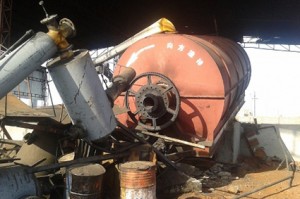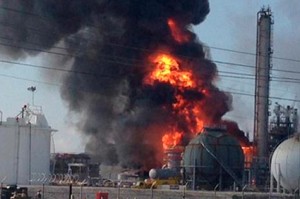Safety became an essential and incredibly important environmental and health security problem in pyrolysis plants since the numerous people were died or seriously injured due to blast caused by pyrolysis plant operation.
 The burning of hydrocarbon waste such as oil slime, old tyres and plastic waste using high temperatures and no-oxygen access is determined as pyrolysis process, otherwise cracking. If the correct process is adopted, wide deployment of pyrolysis can be quite good waste management industry trend.
The burning of hydrocarbon waste such as oil slime, old tyres and plastic waste using high temperatures and no-oxygen access is determined as pyrolysis process, otherwise cracking. If the correct process is adopted, wide deployment of pyrolysis can be quite good waste management industry trend.
Anyway, the hazards connected with pyrolysis process arise from releasing of toxic gases and explosions. Hydrocarbons released from the reactions of pyrolysis are highly combustible. An explosion may take a place under intended heat and oxygen.
In Chennai chemical manufacturing company (India) one accident took place in 2014. The boiler was flung up to 30 meters from the place where the pyrolysis plant was installed. As a result, it killed one man and two others were injured.
In 2011 in industrial area Panchkula (India) an explosion of tyre recycling unit was occasioned due to the high pressure, which caused the burn injuries received by plant operator being that he was standing quite close to the vessel. Another worker got fewer injuries in the fire as the waste tyres caught all fire.
Explosions can be caused by flammable gases leakage from the waste treatment chambers. In the accident happened at a renewable heating oil (bio-oil) production unit at the beginning of 2014 in Joensuu (Finland) three people were died after the process had shut down automatically due to strong oscillation of the liquid levels. The whole unit became surrounded be toxic smoke due to the nitrogen rout was blocked, the hatch was opened and the incoming process gas reacted and led to an explosion inside the industrial area.
In 1998, German pyrolysis plant manufactured for the municipal solid waste processing in Furth suffered a great failure, leading in the release of pyrolysis gas into the air. The whole neighborhood was evacuated, also in the surrounding some residents were brought to the hospital for observation.
In 2012 , at Russian oil sludge treatment plant in the Khanty-Mansiysk pyrolysis gas explosion occurred. The bang claimed the lives of eight people; another eight workers got burn injuries and carbon monoxide poisoned.
At the end of February 2014 in Budennovsk, one of the explosions recorded was the hazard occurred in the high-density polyethylene production plant owned by noted Russian oil company. A fire occurred in pyrolysis gas separation unit due to depressurization of the aluminum warmth.
Such cases can be prevented by controlling the oxygen amount contained in a feedstock, temperature rise and pressure during operational conditions.
— Pyrolysis plants, which are manufactured by IPEC company keep the rising of the temperature even and smooth,2-3 Degrees Celsius per second. The pressure in the camera is controlled by temperature rise rate.
— The system which is controlles automatically monitors all the process parameters
— In case of feed failure or oxygen leak into reactor, nitrogen ramp is designed for the emergency shut down of the plant and controlling the pressure vacuum conditions.
— Flue gas emissions are controlled by multistage flue gas cleaning system where pyrolysis gas is cleaned of acid components.
IPEC pyrolysis plants is the environmentally friendly solution ensures 100% of personal safety.







